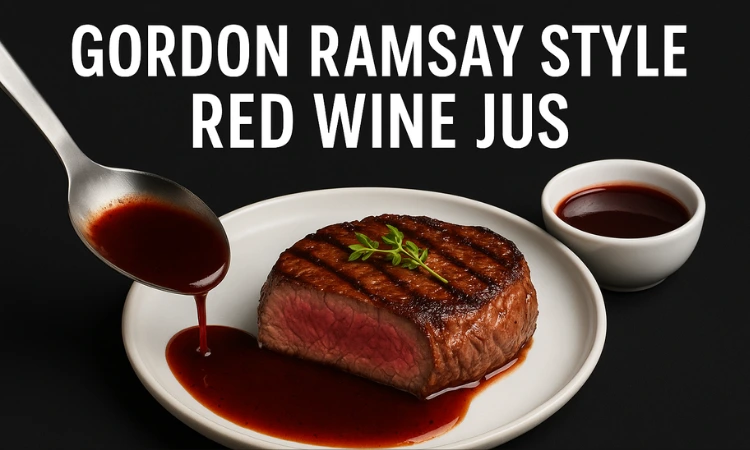Discover how to elevate your steak with a rich, restaurant-quality red wine jus. This classic sauce adds depth, flavor, and elegance to any steak dinner.
Whether you’re just starting out in the kitchen or already comfortable with cooking, this guide teaches you a simple, step-by-step method.
You’ll learn how to create a bold, balanced red wine reduction using everyday ingredients.
This red wine jus for steak will make every bite unforgettable. It is perfect for date nights, family meals, or special occasions.
Say goodbye to bland and hello to a homemade upgrade your steak truly deserves.
What is Red Wine Jus?
Red wine jus is a flavorful, concentrated sauce made from reduced red wine, often combined with beef stock, herbs, and vegetables.
It’s a bit different from a red wine reduction, which typically involves simmering wine to thicken it and enhance its flavors.
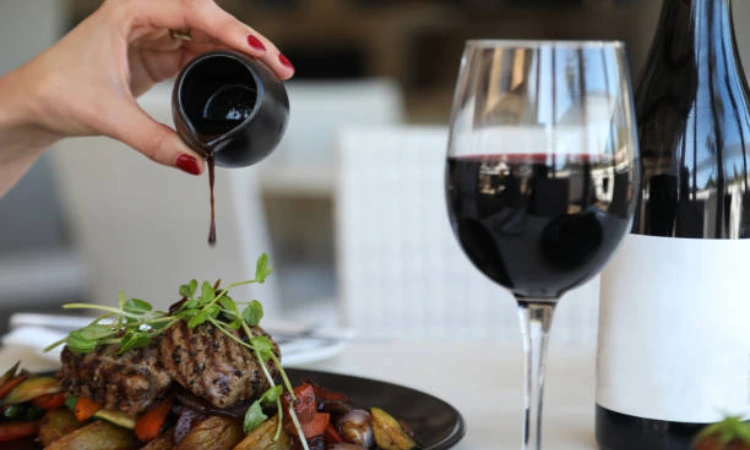
While both sauces use wine as their base, a red wine jus tends to be more liquid and has a smooth texture, perfect for drizzling over meat.
The term “jus” comes from the French word for juice, meaning the meat’s natural juices. Red wine jus has its roots in French cuisine, where it was traditionally used to complement hearty dishes like steak, lamb, or roasted meats.
It is key in enhancing the meat’s richness, adding a deep, savory flavor that elevates the dining experience.
This classic French red wine sauce remains a favorite in fine dining worldwide.
Red Wine Jus Ingredients and Their Functions:
Creating a perfect red wine jus for steak requires a balance of key ingredients.
These ingredients work together to build the deep, savory flavor profile that makes the sauce so special.
The combination of dry red wine, shallots, beef stock, herbs like thyme and bay leaf, and butter creates a rich, flavorful, and velvety sauce.
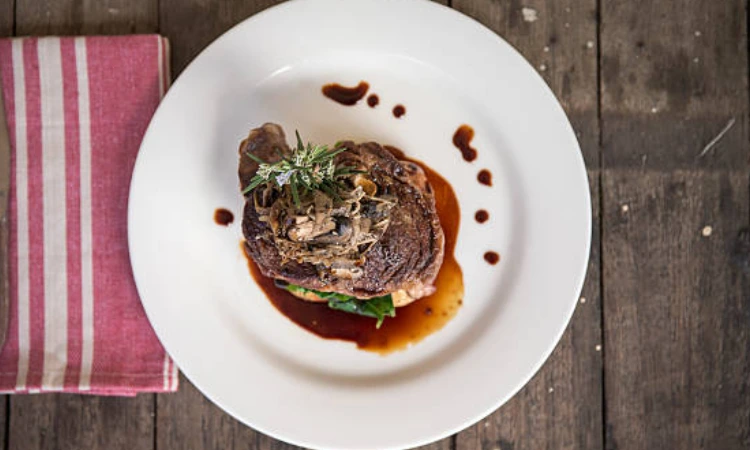
Dry Red Wine
Dry red wine is the backbone of a red wine jus. It imparts rich, fruity, and slightly tannic flavors, intensifying as it reduces.
The wine provides acidity, helping to balance the richness of the beef stock and giving the sauce its signature depth and complexity.
Shallots
Shallots are key to the flavor profile of red wine jus. They bring a mild sweetness and a delicate, onion-like flavor, offering balance without overpowering the sauce.
When caramelized, they provide depth and a subtle richness, contributing to the smooth texture and adding an aromatic layer to the sauce.
Beef Stock
Beef stock is crucial for creating the savory base of red wine jus. It deepens the flavor, contributing umami and a rich, meaty undertone.
As it reduces, the stock thickens the sauce, helping it achieve the desired consistency while enhancing the richness and flavor of the wine reduction.
Herbs (Thyme and Bay Leaf)
Thyme and bay leaf add herbal fragrance to the red wine jus, boosting its flavor complexity.
Thyme offers a fresh, slightly earthy taste, while bay leaves contribute subtle bitterness and depth.
These herbs work synergistically to round out the sauce, enhancing its aroma and providing a more well-rounded flavor.
Butter
Butter adds the final luxurious touch to red wine jus. It smoothens the sauce, contributing to a velvety texture and rich mouthfeel.
The butter helps to balance the wine’s acidity and enhances the sauce’s depth, giving it a glossy finish that elevates the overall flavor profile.
Step-by-Step Guide to Making Red Wine Jus For Steak:
Making red wine jus for steak is an easy yet rewarding process. You can create a flavorful and rich sauce that enhances your steak by following these simple steps.
This step-by-step red wine reduction for steak focuses on sautéing shallots, deglazing with wine, and incorporating stock.
The key is gradually achieving the perfect consistency and flavor balance by reducing the sauce.
Follow these techniques, and soon you’ll pour a restaurant-quality red wine jus over your perfectly cooked steak.
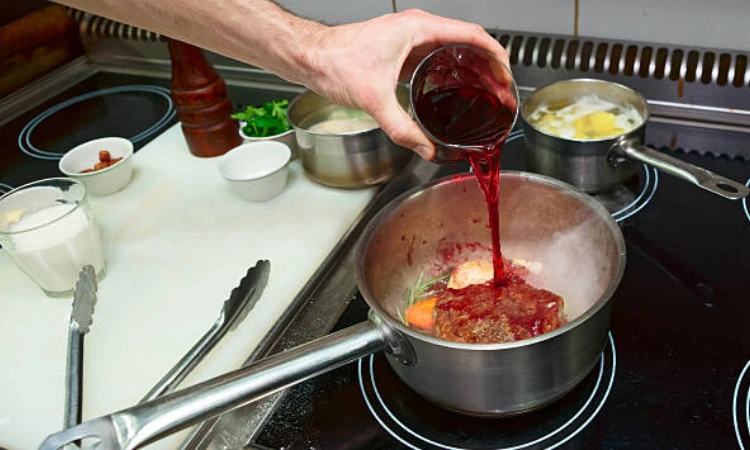
Preparation:
Sautéing Shallots
- Start by sautéing finely chopped shallots in butter in a pan.
- Cook them until soft and translucent, but be careful not to brown them.
- This will release their natural sweetness and enhance the flavor base of your red wine jus, providing a savory, aromatic foundation for the sauce.
Deglazing the Pan
- Once the shallots are sautéed, deglaze the pan with dry red wine.
- Pour in the wine and stir to lift any caramelized bits stuck to the bottom of the pan.
- These bits add concentrated flavor, making the sauce richer and more complex.
- Let the wine simmer to cook off the alcohol.
Reducing the Wine
- Allow the wine to reduce by about half. This process intensifies the flavors and helps concentrate the sauce.
- Keep the heat moderate and stir occasionally to prevent burning.
- As the wine reduces, it will become thicker, and the concentrated flavors will form the base for your red wine jus.
Incorporating Stock
- After reducing the wine, add beef stock to the pan.
- Stir to combine and continue simmering. The stock adds savory depth and richness to the jus, balancing the acidity of the wine.
- Allow the sauce to simmer and reduce further, achieving the desired consistency.
- Taste and adjust seasoning if necessary.
Techniques: Achieving Perfect Consistency & Flavor Balance
To perfect the red wine jus, monitor the reduction process carefully.
- If the sauce is too thin, let it reduce further to thicken.
- If it’s too thick, add a bit more stock.
Taste frequently and adjust the seasoning with salt, pepper, or a pinch of sugar to balance the flavors.
Gordon Ramsay’s Signature Red Wine Jus Recipe:
Gordon Ramsay’s approach to red wine jus combines technique and high-quality ingredients, creating a rich and complex sauce.
His version highlights the importance of caramelizing shallots and carefully reducing the wine and stock for depth.
With a few variations, such as adding butter or herbs, Ramsay’s red wine sauce transforms any steak into a restaurant-quality dish.
Whether following his signature recipe or adding your own twist, the key is to balance flavors and perfect the reduction process.
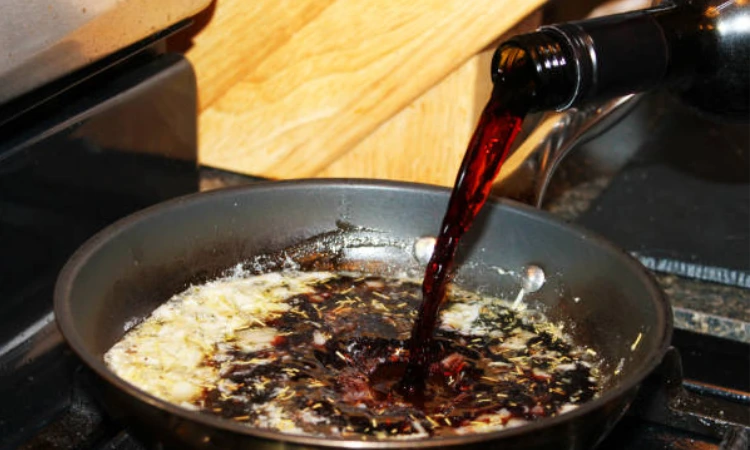
Gordon Ramsay Red Wine Jus Recipe Overview
Gordon Ramsay’s red wine jus involves balancing key ingredients such as shallots, dry red wine, and beef stock.
His method includes sautéing shallots to bring out their sweetness, deglazing with wine, reducing it, and incorporating stock for richness. The result is a perfectly balanced, flavorful sauce.
Chef’s Tips: Enhancing Flavor through Caramelization & Proper Reduction
Ramsay’s signature tips for red wine jus emphasize the importance of caramelizing shallots until they are golden brown, bringing out their sweetness.
He recommends reducing the wine slowly to intensify its flavors and concentrate its acidity. This careful process ensures a smooth, rich sauce with deep flavor layers.
How to Pair Red Wine Jus with Steak Cuts?
Pairing red wine jus with steak can elevate any cut of beef into a gourmet experience. The rich, savory sauce enhances the steak’s natural flavors, particularly when paired with cuts like ribeye, filet mignon, or sirloin.
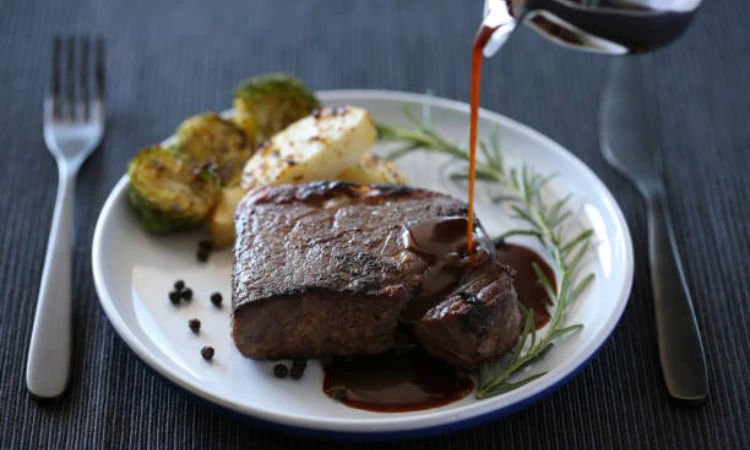
Understanding how different doneness levels affect the pairing can further refine the flavor profile.
Whether you prefer a classic steak accompaniment or a bold new twist, red wine jus brings an unmatched depth and complexity to your steak dish.
Best Pairings: Ideal Steak Cuts for Red Wine Jus
Red wine jus pairs exceptionally well with rich cuts like ribeye, with a fatty marbling that complements the sauce’s depth.
Filet mignon’s tenderness balances the sauce’s intensity, while sirloin offers a meaty, leaner option.
Each of these cuts benefits from the sauce’s complex flavors, enhancing their natural taste.
Cooking Levels: How Doneness Levels Affect the Pairing and Flavor Profile?
The steak’s doneness affects how the red wine jus interacts with the meat.
A rare steak will allow the sauce to contrast with the more delicate flavors, while a well-done steak absorbs the sauce’s richness more deeply.
Adjust the sauce’s thickness and seasoning based on the steak’s doneness.
Common Mistakes While Making Red Wine Jus and How to Avoid Them?
When making red wine jus, it’s easy to make a few common mistakes that can compromise the flavor and consistency.
Over-reduction can lead to bitterness, while choosing the wrong wine can affect the sauce’s balance.
This section addresses these pitfalls and provides simple solutions. Whether making red wine jus for the first time or perfecting your recipe, knowing how to avoid these mistakes will help ensure your sauce complements the steak perfectly.
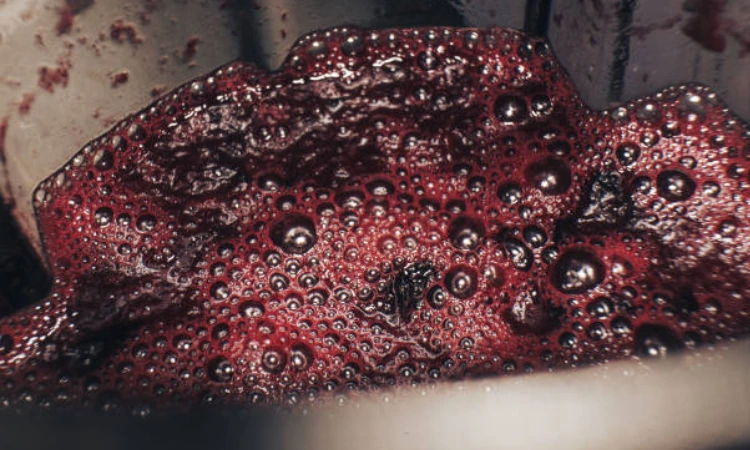
Pitfalls: Over-Reduction, Bitterness, Incorrect Wine Selection
Over-reducing the sauce can cause it to become too thick or bitter. Choosing the wrong wine, like one that’s overly tannic or sweet, can disrupt the sauce’s flavor balance, making it unpleasant.
Solutions: Adjusting Flavors, Correcting Consistency, and Choosing the Right Wine
Add a pinch of sugar or honey to fix the bitterness and balance the flavors. If the sauce is too thick, incorporate more stock. Always choose a dry red wine with balanced acidity for the best results.
Alcohol-Free Red Wine Jus Alternatives:
For those who prefer to avoid alcohol, there are several excellent alternatives to create a rich, flavorful red wine jus.
Options like grape juice, non-alcoholic wine, or vinegar blends can mimic the depth and acidity of red wine without the alcohol content.
These alternatives allow you to enjoy the same savory, tangy flavors, ensuring your steak still receives the perfect accompaniment.
Whether you’re cooking for dietary preferences or kids, these alcohol-free versions will satisfy your craving for a luxurious steak sauce.
Substitutions:
Grape juice can replicate the sweetness of wine, while non-alcoholic wine offers similar acidity and flavor profiles. Like red wine vinegar with water, a vinegar blend balances tartness and depth.
Flavor Adjustments:
Add a dash of balsamic vinegar for richness, or use concentrated stock for a robust flavor to maintain depth. Incorporating herbs like thyme and bay leaf enhances the overall complexity.
Vegetarian and Vegan Variations of Red Wine Jus:
Creating a vegetarian or vegan version of red wine jus doesn’t mean sacrificing flavor. You can maintain a rich, savory base by substituting beef stock with mushroom or vegetable stock.
Umami-rich ingredients, such as miso or soy sauce, add depth to the sauce, ensuring it’s just as flavorful as the traditional version.
Whether catering to plant-based diets or simply experimenting with different flavors, these variations provide a delicious, cruelty-free alternative to the classic red wine jus.
Stock Alternatives:
Mushroom stock adds an earthy richness, while vegetable stock offers a lighter, yet savory base. Both can effectively replace beef stock, ensuring a full-bodied sauce without using animal products.
Flavor Enhancers:
To boost umami in a vegetarian or vegan red wine jus, try adding ingredients like miso paste, soy sauce, or tamari. These elevate the flavor profile, giving the sauce depth and complexity.
Red Wine Jus Storage, Reheating, and Reuse Tips:
Proper storage is essential to extending the life of your red wine jus. Refrigerating or freezing it allows you to enjoy your sauce later without losing flavor.
When reheating, restoring the sauce’s original texture and depth is essential. Additionally, leftover red wine jus can be creatively reused in various dishes, such as stews or soups.
These tips help you make the most of your red wine sauce, reducing waste while enhancing your meals with rich, savory flavors.
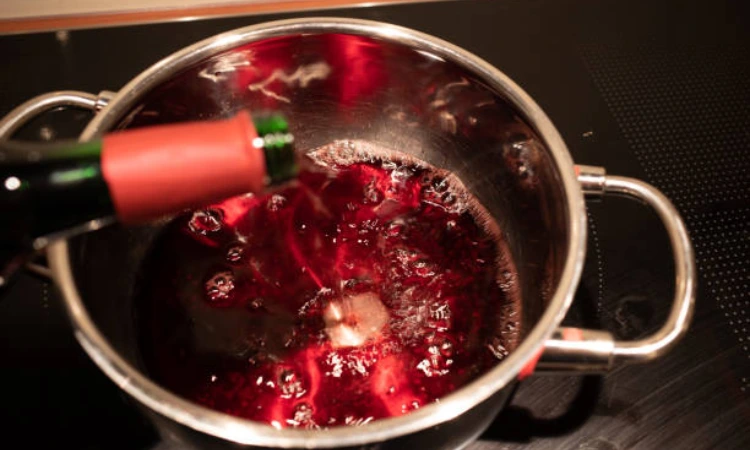
Storage Guidelines:
You can store your red wine jus in an airtight container in the fridge for up to 3 days. For longer storage, you can freeze the sauce in portions, ensuring it’s fully cooled before freezing.
Reheating Methods:
Reheat red wine jus gently over low heat to preserve its smooth texture and flavor. Stir frequently to prevent separation, and add a splash of stock if the sauce thickens too much.
Reuse Ideas:
Leftover red wine jus can be added to gravies, stews, or risottos for added richness. It also serves as a base for soups, pasta sauces, or braising meats.
Red Wine Jus Pairing Recommendations:
When pairing wine with steak and red wine jus, the goal is to enhance both the sauce and the meat.
Full-bodied red wines like Cabernet Sauvignon, Merlot, or Syrah complement the rich flavors of the steak and red wine sauce.
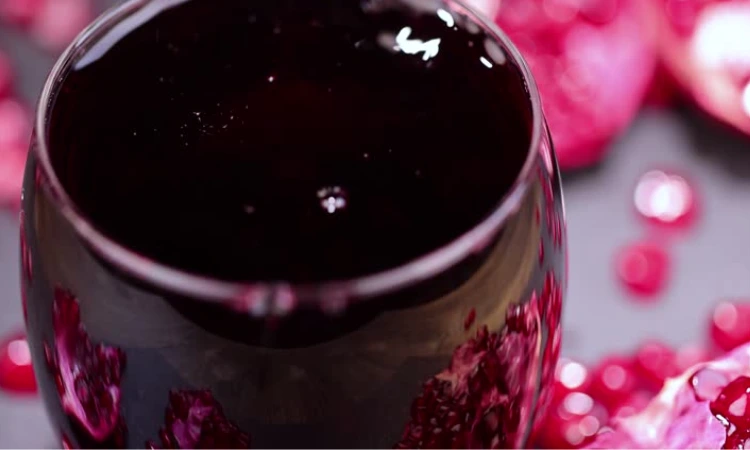
The wine’s tannins balance the sauce’s acidity, while the wine’s fruitiness adds a layer of complexity to the dish.
By understanding how different wines interact with your steak and sauce flavors, you can create a dining experience that truly elevates the meal.
Complementary Wine
Full-bodied red wines such as Cabernet Sauvignon, Merlot, or Syrah work well with red wine jus. Their tannins balance the sauce’s acidity, while their bold flavors complement the rich steak.
Tasting Notes:
Tannins in red wine help balance the acidity of the red wine jus, while fruity notes complement the savory flavors of the steak. Choose wines with depth for added complexity.
Quick Fixes for Common Issues When Making Red Wine Jus
When making red wine jus, it’s common to face issues like consistency or flavor imbalances.
If your sauce is too thick or too thin, simply adjust it by adding more stock or reducing it further. Flavor imbalances can occur, but they’re easy to fix.
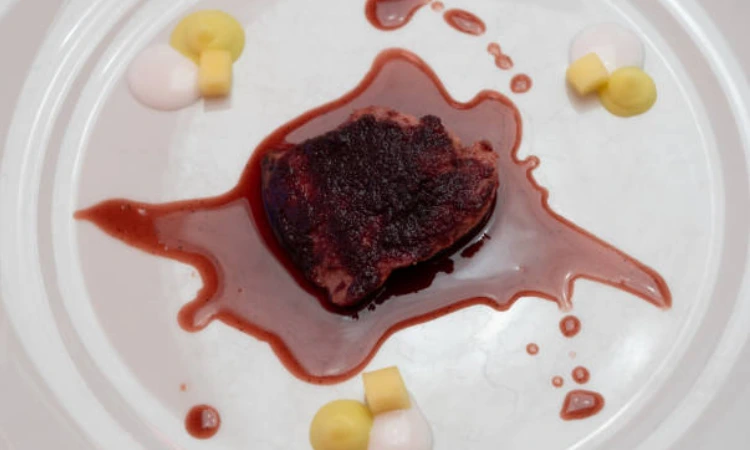
Adjusting acidity, sweetness, or saltiness can restore balance. By following these simple troubleshooting tips, you can ensure your red wine jus is always the perfect complement to your steak.
Consistency Problems:
- If your red wine jus is too thick, add a splash of beef stock or water to loosen it.
- If it’s too thin, let it simmer longer to reduce and thicken.
Flavor Imbalances:
- Add a pinch of sugar or honey if your sauce is too acidic.
- If it’s too salty, add more stock.
- Balance acidity by adjusting the wine reduction to your taste.
Conclusion:
Making a delicious red wine jus is simple with the right technique and ingredients. By following the key steps, you can create a rich, flavorful sauce that enhances any steak.
Don’t hesitate to experiment with variations. Share your experiences or ask questions in the comments below – we’d love to hear from you!
Related: Proven Tips for the Perfect France Wine Tour in 2025

